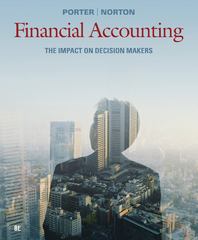Question
NEED HELP WITH NUMBER 10! ALL OTHER QUESTION ANSWERS MIGHT AIDE IN HELPING ANSWER NUMBER 10! Problem 4: What are in investment proportions in the
NEED HELP WITH NUMBER 10! ALL OTHER QUESTION ANSWERS MIGHT AIDE IN HELPING ANSWER NUMBER 10!
Problem 4: What are in investment proportions in the minimum variance portfolio of the two risky funds, and what is the expected value and standard deviation of its rate of return?
Expected rt on stock fund: .20
Expected return on bond fund: .12
SD of stock fund: .3
SD of bond fund: .15
Correlation between fund returns: .1
Variance of stock fund: .30^2= .09
Variance of bond fund: .15^2= .0225
Covariance of stock and bond funds [COV(sb)]: .0045
Minimum portfolio variance (Ws)= [(.0225-.0045)]/[.09+.0225]-2(.0045)
Portfolio Invested in Stock (Ws)= (.0225-.0045)/(.0225+.09-2*.0045)= 17.39%
Portfolio invested in Bond (Wb)= 1-portfolio invested in stock: 1-.1739= .8261
Expected return on minimum variance portfolio: E(rs)x Ws +E(rb) x Wb = 13.39
SD of minimum variance portfolio: ((.1739^2)(.09)+(.8261)^2*(.0225)+2*.1*.1739*.8261))^1/2= .1392
Problem 7: Solve numerically for the proportions of each asset and for the expected return and standard deviation of the optimal risky portfolio.
Weight (stock)= ((.2-.08)*.0225-(.12-.08)*.0045))/((.2-.08)*.0225-(12%-8%*.0045)/((20%-8%)*.0225 + (12%-8%)*.09-((20%-8% + 12% -8%)*.0045) = .4516
Weight (Bond)= 1-Weight(stock)
Weight bond= .5484
Portfolio standard deviation= SQRT(((45.16%^2)*.09)+((54.84%^2)*.0225)+(2*45.16%*54.84%*.0045))
Portfolio Standard Deviation = 16.54
Expected rate of return: 45.16%+20%+54.84%*12%
Expected Rate of Return= 15.61%
Problem 8: What is the Sharpe Ratio of the best feasible CAL?
Sharpe ratio= mean portfolio return-risk free rate)/sdv of portfolio return= (15.61%-8%)/16.54%
Sharpe Ratio= .46
Problem 9: You require that your portfolio yield an expected return of 14%, and that it be efficient, on the best feasible CAL?
Part a: What is the standard deviation of your portfolio?
E(r)= (.14-.12)/(.2-.12)= .25
Portfolio has 25% in the stock fund
75% in the bond fund
Std dev. = ((.25)^2(.3)^2+(.75)^2(.15)^2+ 2(.25)(.75)(.3)(.15)(.1))^1/2 = .141
Part b: What is the proportion invested in the T-Bill fund and each of the two risky assets?
.14= .08+y*[.1561-.08]
.14-.08=y*.0761
.06/.0761= .7884
Proportion of investment in T-bills = 1-y = 1-.7884= .2116
Proportion of Investment in stock fund = .7884*.4516= .356
Proportion of investment in Bond fund= .7884*.5484= .4324
Problem 10: If you were to use only the two risky funds, and still require an expected return of 14%, what would be the investment proportions of your portfolio? Compare its standard deviation to that of the optimized portfolio in Problem #9. What do you conclude?
Step by Step Solution
There are 3 Steps involved in it
Step: 1

Get Instant Access to Expert-Tailored Solutions
See step-by-step solutions with expert insights and AI powered tools for academic success
Step: 2

Step: 3

Ace Your Homework with AI
Get the answers you need in no time with our AI-driven, step-by-step assistance
Get Started


